
Norrköping, Sweden
When are green cars going to be green enough to be worth buying? With the cost of gas increasing at the current rate, electric plug-in vehicles are becoming the brightest alternative. Why bother with a gasoline engine when you can plug in your car each night for the same cost as running your washer or dryer? Not to mention having a virtually silent power source for your car. It seams like a no-brainer to me. So what are the options available today and in the near future?
In keeping with our name Fast Wallpapers, the Tesla Roadster is the only high performance model available to date. With a 0-60 mph time in around 4 seconds and a top speed of 130 mph, these stats touch into super car territory. With up to 250 miles per charge and a charging time of 3.5 hours using an electrician-installed home kit, this is the best out there. Charging from a standard outlet is available too.
A recent addition to the Electric car line up is the Subaru R1e. The R1e is still in testing mode, but it looks like Subaru is intent on taking this little car to production. No word on when this would be. Some suggest that the R1e could be available to consumers in Japan as early as 2009. With the constant improvements in battery technology, it is hard to say what the production R1e will be capable of, but there are prototype versions already on the streets capable of 75 miles on a single charge. Engineers estimate that the production version may be capable of 125 miles on a charge. This joint battery development between Subaru and NEC is reported to be capable of recharging to 90% capacity in five minutes with a lifespan in excess of 93,000 miles. You can read more about this economy electric car at drive.subaru.com.
The California based Aptera, Greek for “wingless flight” has a very promising prototype. The Aptera Typ-1 is technically a motorcycle, this two-seat, three-wheeled vehicle looks more like an experimental aircraft then a car. Manufacturing the Typ-1 is set for later this year. The first production versions could be rolling down the streets of California as early as October. They are planning on producing 2 versions, the Typ-1e and Typ-1h. The e denotes electric and the h, gasoline electric hybrid. The Typ-1e is said to have a range of 120 miles and a complete charge in 2 to 4 hours at a projected cost of $1-2.
Pricing for the all-electric version will be $26,900, and the plug-in hybrid should be about $29,900. You can even reserve yours at their website aptera.com.
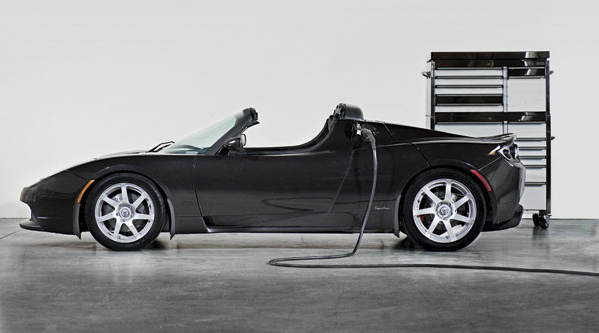

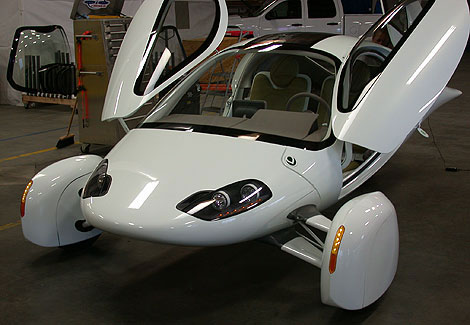
Subaru is finally releasing the 2008 Impreza WRX STI Rally Car at the Greek Rally. The new car is shorter wider and lighter then the outgoing WRC 2007 model.

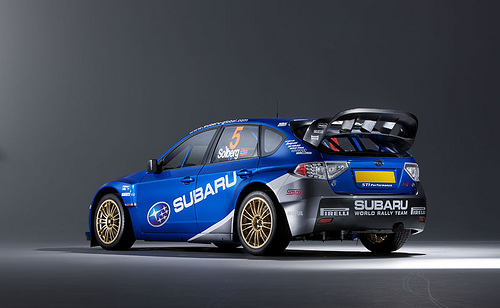
Its official, after years of anticipation the Ferrari Dino or Baby Ferrari F149 is here and it has been worth the wait. Only limited details about the new California, as it will be called have been released to date. The California will be V8 powered despite speculation of a V6 propelling the baby Ferrari. The engine will be an all new 4.3 liter V8 engine, which is the same size as the engine in the current F430. This new engine will feature direct injection and a flat crankshaft, power is said to be around 450 at 7,500 rpm, which would make it marginally less powerful then its bigger brother the F430 but more fuel efficient and easer on the sky thanks to reduced C02 emissions. Option reductions limit customers to only a 7 speed dual clutch transmission. Performance has not been sacrificed with 0-60 mph run said to be accomplished in under 4 seconds. The California will only be available as a hard-top convertible, which is a departure from Ferrari’s traditional canvas soft-top. Pricing is expected to be in the realm of Porsche 911, Aston Martin V8 Vantage, Mercedes Benz SL class with which it will co. More info will be available right here when the 2009 Ferrari California is reviled at the Paris Auto Show.
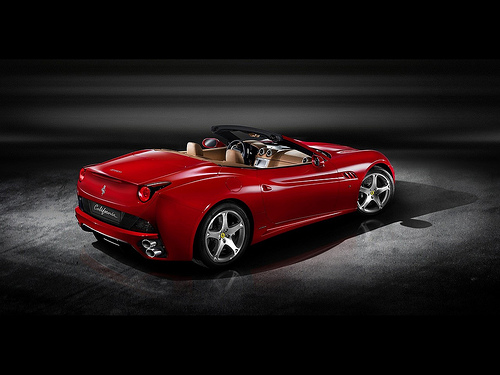
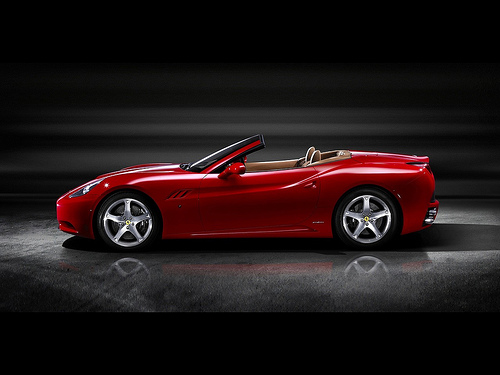
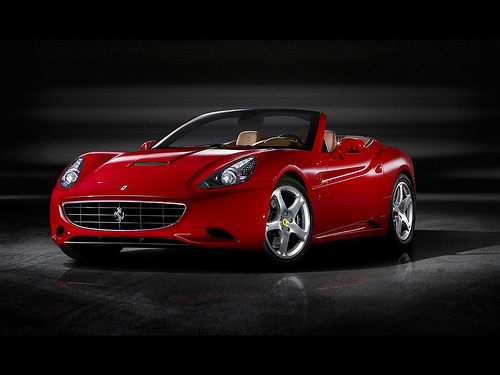
Maranello, May 13th 2008 — The first official photographs have been published of the Ferrari California, the latest addition to the new generation of Ferraris launched in 2004 with the 612 Scaglietti and added to more recently with the 430 Scuderia. The Ferrari California joins the Prancing Horse’s 8-cylinder family which has always been defined by power and performance. It also flanks the flagship 612 Scaglietti in the prestige sporty Grand Tourer segment. The new Ferrari California will satisfy even the most demanding of owners in term of its superb vehicle dynamics and driving pleasure. The new model will be available exclusively as a convertible with a folding hard top. Both chassis and bodywork are aluminium, in line with the rest of the current range. The California will be powered by a new V8 engine mounted for the first time in the marque’s history in the mid-front position. In line with Ferrari tradition, the new model also features several innovations. Apart from its folding hard top, these include the original 2+ concept which guarantees exceptional versatility of use in the rear of the car. The California’s 4,300 cc V8 engine features direct fuel injection and a “flat” crankshaft. It generates 460 CV at 7,500 rpm with a torque curve that enhances vehicle dynamics and provides maximum driving pleasure which is typical for Ferrari. As per the traditional Ferrari transaxle layout, the engine, which allows the Ferrari California to sprint from 0 to 100 km/h in less than 4.0 seconds, will be coupled to a 7-speed dual clutch transmission that boosts the car’s performance while enhancing the driving pleasure, improves ride comfort and reduces fuel consumption and emissions (c.310 g/km CO2). The comfort is further enhanced by a new multilink rear suspension system. The Ferrari California is also equipped with the exclusive F1-Trac traction control system which made its debut on the 599 GTB Fiorano and has been further honed to suit the typical driving conditions expected for this new GT. Brembo brakes featuring carbon-ceramic material disks as standard guarantee superbly efficient braking. In addition to sporting the marque’s classic styling cues, the cabin has also been beautifully trimmed using quality materials by Ferrari’s own skilled artisans. New accessories and equipment, such as the seats, steering wheel, instrument panel and infotainment system, together with optimised aerodynamics ensure that this is a highly ergonomic and enjoyable car to drive regardless of whether the top is up or down. The Ferrari California is aimed at owners who desire a car which embodies everything the Prancing Horse represents in terms of sporty design and innovation, but also seek a car with greater versatility than ever. The car will be officially unveiled to the public at the Paris International Car Show. However, over the coming weeks, new photographs and further details about it will also be published.
Subaru has at last revealed the new Impreza WRX STI. This new version is a step away from the old philosophy. The word refined comes to mind when siting in the new plush cabin. The wagon only styling is a real let down. The STI styling is a big improvement from the base WRX but wider body work and spoilers aren’t enough. Why won’t Subaru build a 2 door Impreza coupe again? That is what so many sports car enthuses want. Who in the right mind wants a 4 door sports car? All that extra weight slows the car and hurts fuel economy. Smaller is better when it comes to sports cars. Check out our gallery for lots more hi-res desktop wallpapers of the 2008 Subaru WRX STI.
Aston Martin has made the best-looking cars since 1913. And the V12 Vantage RS is no exception. The V12 Vantage RS is based on the V8 Vantage. The V8 Vantage has been beloved ever since its introduction in 2006. The only criticism for the V8 has been its lack of power. A 380 horsepower 4.3 liter V8 produced good power but lacked real Super Car performance. Now free from the death grip of Ford motor company, Aston’s new leadership decided to make big news with a V12 Vantage RS concept. The engine of choice was the V12 engine from the DBR9 racecar that produces over 600 hp. This engine would add just under 200 pounds to the curb weight of the Vantage, but Aston engineers’ found a way to strip over 300 pounds from the chaise to a total weight of 3420 pounds.
To put this all in perspective, the 2007 Subaru STI weighs in at 3300 pounds and with 300 horsepower it can accelerate to 60 in 4.7, which is the same as the V8 Vantage. The V8 Vantage’s additional 80 hp is not enough to push the 300 extra pounds faster than the Subaru. The V12 Vantage’s 610 horsepower is almost double the original output and improves the Vantage’s time to the sub 4-second range. This 610 hp engine is also in the new DBS. With the DBS’s additional 350 pounds, it slows its 0-60 sprint to 4.3 seconds. All in all very respectable performance from the new V12 Vantage RS.
When the V12 Vantage RS hits showrooms in 2009 except to pay close to 200,000 each in a limited run of around 100 unites per year. It may be one of the most beautiful cars Aston Martin has ever produced and better looking than the DBS.
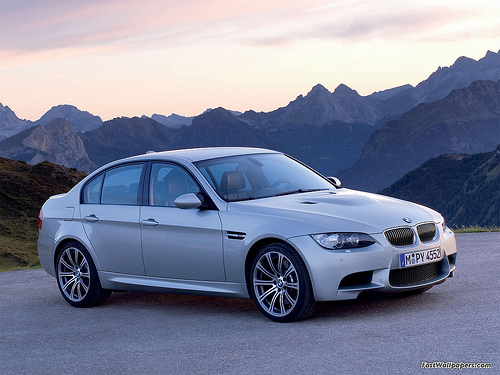
The Official BMW Press Release:
Woodcliff Lake, NJ — October 6, 2007 BMW raises the performance benchmark once again with the introduction of the 2008 M3 Sedan. Sharing the M3 Coupe’s high-revving 414-horsepower V8 and balanced chassis that is designed to be ‘faster than its engine’, the motorsports arm of the German auto maker, BMW M GmbH, is pleased to offer the most powerful, highest-performing M3 ever with four doors.
Originally offered in 1986 as a homologation special to allow BMW’s entry into the German Touring Car Championship, the M3’s popularity and steadily increasing sales for each iteration motivated the company to continue developing this unique combination of driving dynamics, comfort and luxury in a compact machine and offer a new version each time the underlying 3 Series was reborn. Americans were first introduced to the M3 sports sedan concept in 1988. The first M3 produced 192 hp from its 2.3-liter four-cylinder engine during its 1988-1991 model year run. A legend was born and Americans embraced the high-rpm, naturally-aspirated M concept. The next generation arrived in 1995 with a 3.0-liter (and later, 3.2-liter) 240-hp inline-six powerplant. In 1997 the first M3 Sedan joined the family and the first M3 Convertible followed shortly thereafter. The most-recent version, available as either a coupe or convertible from 2001-2006, again was offered with six-cylinder power, this time providing 333 hp from its 3.2 liters. This vehicle was BMW’s first use of SMG (Sequential Manual Gearbox) for the US market.
The all-new 2008 M3 Sedan and M3 Coupe that arrived in spring 2008 will feature the first V8 in a series-production BMW M3. It will also feature driver-adjustable settings for crucial dynamic controls including steering, damping and stability (and an available steering-wheel-mounted “MDrive” button to store the preferences) and a sumptuous interior that can be optimized to a driver’s desires including the comprehensive entertainment/navigation system operated through BMW’s latest iDrive controller.
Lightweight, efficient V8 at the heart of the BMW M3
The move to eight cylinders in the fourth generation BMW M3 provides a powerplant offering the seemingly disparate characteristics of more power, increased efficiency and reduced weight when compared with the previous six-cylinder M3 engine. Displacing 3,999 cubic centimeters (4.0 liters), the new light-alloy engine produces 414 hp at 8,300 rpm and 295 pound-feet of torque at 3,900 rpm with 85 percent of the maximum torque available consistently through 6,500 rpm. This power output represents a 15-percent increase over the six-cylinder from the last generation M3 and it comes with an eight-percent fuel-economy improvement when compared to its predecessor. Compression ratio is dialed in to 12.0:1 and redline is set at 8,400 rpm.
The V8-power unit within the engine compartment of the new BMW M3 Sedan boasts the company’s variable double-VANOS camshaft management. Offering extremely fast and responsive valve timing, this technology reduces charge cycle losses and improves the output, torque and response of the engine, with a positive influence on fuel economy and emission management.
A separate throttle butterfly for each cylinder — eight in this instance — is a feature adapted from BMW M’s racing heritage and provides immediate reaction to the gas pedal at all times. Two stepper motors operate the four throttle butterflies on each row of cylinders, giving the engine a particularly sensitive response at low speeds together with an immediate reaction whenever the driver presses down the accelerator for extra power and performance.
A volume flow-controlled, pendulum-slide cell pump supplies the engine with lubricating oil, delivering the quantity required by the engine. Wet sump oil lubrication, optimized for dynamic performance, ensures consistent oil supply to the high-rpm engine at all times, particularly in extreme braking maneuvers. The system features two oil sumps-a small oil sump in front of the front axle subframe and a large oil sump behind it.
A new, comprehensive electronic management system coordinates all engine functions with optimum efficiency and maximizes operational integration with the clutch, gearbox, steering and brakes. In addition, the engine control unit performs a wide range of on-board diagnosis functions and masterminds the ancillary engine units.
A highlight of the engine management system is the use of ion-current technology to determine engine knock as well as misfire and poor combustion events within the cylinders. Contrary to conventional methods, this monitoring and control function is performed precisely where the phenomena occurs-within the combustion chambers. The spark plug in each cylinder senses and controls the risk of knocking, at the same time monitoring the correct ignition and recognizing any misfiring. In other words, the spark plug acts as an actuator for the ignition and as a sensor monitoring the combustion process, and is therefore able to distinguish between a misfire and poor combustion. This dual function of the spark plugs facilitates the diagnostic procedures required in service and maintenance.
And the increased performance with better economy comes from the lightweight engine. At 445 pounds, it is seven percent or 33 pounds lighter than the previous model’s Inline-6.
Lightweight components do not stop with the alloy engine block. The crankcase is made of a special aluminum-silicon alloy eliminating the need for cylinder liners. Despite the need to resist high combustion pressures and engine speeds-this is the “fastest” production engine ever produced by BMW as it can reach 8,400 rpm-the engineers managed to keep the compact and rigid crankshaft weight down to 44 pounds.
Manual transmission, twin-disc clutch and Variable M Differential Lock
Power from the BMW M3 Sedan’s V8 is transmitted to the rear wheels through a close-ratio six-speed manual gearbox. The performance parameters of the M3 dictated heat management as a key design factor for both the transmission and clutch. The transmission features integrated temperature-dependent oil cooling management, while internal ventilation maximizes heat dissipation for the twin-disc clutch.
The new final drive comes with a Variable M Differential Lock generating up to 100 percent locking action with fully variable action whenever required, ensuring optimum traction on all road surfaces.
Engineering a chassis which is “faster than the engine”
Providing sure-footed responsive handling for a high-performance, powerful and luxurious sedan, while keeping mass under control, presented numerous challenges for the BMW M3’s engineers. The result is a new, aluminum chassis developed specifically for this model. The design begins with placing components in such a way as to create a 50/50 front/rear weight balance.
Virtually all of the front-end components are aluminum, including the front struts, swivel bearings, central subframe and an additional thrust panel below the engine serving to maximize lateral stiffness of the entire front section.
From the rear axle subframe through the transverse arms and track arms, on to the wheel mounts re-configured in their kinematics and stiffness and even the mounting points for the longitudinal arms are now even lighter, all the way to the aluminum dampers. Virtually every detail on the five-arm rear axle made of aluminum is new for this model. These weight-reduction measures and materials help reduce weight by approximately 5.5 pounds when compared to the previous M3.
Both the front and rear axles feature hollow anti-roll bars optimized for their function and weight. Incorporating two additional longitudinal reinforcement bars, axle kinematics are perfectly tailored to the overall character of the car. The result, in terms of both stability and weight, conforms to the balanced performance concept of the BMW M3 Sedan. Compound brake system
A suitably stout braking system for a car with this much performance was specifically developed for the new M3. Featuring large compound disc brakes and electronic anti-lock, stopping power for the new BMW M3 is strong, precise and consistent. The internally-vented, cross-drilled cast iron discs measure14.2 inches in diameter at the front and 13.8 inches in the rear. They are connected to a floating aluminum hub by cast-in stainless-steel pins. This configuration reduces the thermal loads on the discs, thus increasing their performance and service life. An electrically-driven pump provides the system’s vacuum power.
Service — and safety — is enhanced thanks to an ongoing wear indicator which, through a dash display, allows the driver to monitor the condition of the brake linings. Brake service can thus be administered when necessary without guesswork.
Standard M-style light-alloy spoked wheels measure 18 x 8.5 inches with 245/40 low-profile tires at the front and 18 x 9.5 with 265/40 tires at the rear, can be supplemented by optional 19-inch versions in comparable widths and design.
Servotronic steering with two manually adjustable control maps
Rear-wheel drive keeps the rack-and-pinion steering of the BMW M3 Sedan free of drive forces. A further enhancement is hydraulic Servotronic power assistance controlling steering forces as a function of road speed. There is also a choice of two different control maps activated through normal and sport modes with a console-mounted button.
In Sport mode the BMW M3 provides direct and immediate response with a relatively high steering effort. In the Normal mode, power assistance is comfort-oriented and requires less steering effort.
Latest-generation of Dynamic Stability Control
The electronic Dynamic Stability Control (DSC) monitors driving conditions and intervenes through the application of brakes and reduced engine power to stabilize the BMW M3 and help avoid major over- or under-steer situations.
In addition to engine controls and the ABS, other systems integrated in the DSC are Automatic Stability Control (ASC), which prevents the wheels from spinning on surfaces with reduced traction; the Start-Off Assistant, which prevents the car from rolling back when setting off on a grade, as well as Cornering Brake Control (CBC), which prevents the car from spinning or swerving out of control when applying the brakes in a bend.
The latest version of DSC includes additional functions for even greater driving safety. Whenever the driver is likely to apply the brakes in full within the next few seconds, the system builds up pressure in the hydraulic brake circuit and pre-loads the brake pads to ensure an immediate response. The Dry Braking feature removes water film from the discs in wet conditions, thus reducing the chance of water interfering with the braking process.
Electronic Damper Control recognizing the driver’s style of motoring
The optional Electronic Damper Control (EDC) allows the driver to tailor the vehicle’s chassis dynamics to his or her preference through one of three modes: Sport, Normal and Comfort. The response of all dynamic driving systems is carefully tailored to the power and performance of the new BMW M3, with electronic intervention of the various systems naturally taking the dynamics of the car into account. Indeed, the driver even has the option to individually configure specific parameters, thus adjusting the response of the car to his personal preferences.
MDrive personalizes the driving characteristics of the new BMW M3
The new M3 provides several standard and optional driver-controlled systems to tailor the driving characteristics to a driver’s personal preferences. The driver can choose, with conveniently located buttons:
A push of the MDrive button on the steering wheel can instantaneously activate the above driver-selectable configurations, turning the new BMW M3 into his or her personalized Ultimate Driving Machine. The settings are stored through menus shown on the dash-mounted screen and controlled by the iDrive (located in the center console). Storing one’s overall preferences under the MDrive allows the driver to modify any of the adjustable settings, yet return to his or her optimum with a simple press of the MDrive button. This feature requires the Navigation/iDrive option.
Athletic, sporting stance separates new BMW M3 Sedan from the pack
Front to back, the design of the new BMW M3 Sedan evokes a purposeful, sporting message. The front end, though clearly a BMW based on the double-kidney shaped grill, flat headlight units with standard Xenon headlamps, boasts three large air intakes below the grill. Since the structure and configuration is determined to primarily feed air into the engine compartment, the BMW M3 Sedan, like BMW M cars in general, intentionally forgoes fog lamps featured on 3 Series models.
The ‘face’ of the new BMW M3 also includes a power dome in the middle of the aluminum hood which, though longer than that of the 3 Series Sedan, blends harmoniously with the overall design.
The two front side panels boast a special sign of distinction characteristic of a BMW M Car and referred to by the designers as ‘gills,’ which incorporate the tri-color (blue/purple/red M3) logo. Rear-view mirrors developed for the new BMW M3 fulfill an important aerodynamic function helping reduce air resistance. Further down the side-line, the pronounced side-sills, give the BMW M3 a light and sporting look.
The new BMW M3 Sedan looks muscular from behind, its design taking up the particular look of the car’s front end. A discreet lip spoiler on the trunklid optimizes the car’s streamlining and reduces lift on the rear axle. In its contours, the split diffuser beneath the rear bumper takes up the shape of the air intakes at the front of the car as the air guide and the dual tailpipes move towards the centerline of the car, visually contracting the rear end at the lower center point. A further feature is the circular shape of the four straight tailpipes in typical BMW M style.
The four metallic paints reserved for BMW M cars (Melbourne Red, Jerez Black, Interlagos Blue and Silverstone) highlight the body, contours and proportions of the four-door with particular intensity. In addition to these unique hues, the BMW M3 is available in Alpine White, Jet Black, or Sparkling Graphite Metallic.
Interior design oriented an active driving experience with luxury
The interior of the BMW M3 has always been a place designed for performance driving, but without compromising the comfort of the driver and the passengers. The new BMW M3 Sedan continues this tradition with the latest innovations. The five seats are surrounded by powerful contours and flowing lines highlighting in particular the concave and convex surfaces. The horizontal lines dominating the area around the dashboard as well as the harmonious surfaces of the side linings give the interior a dynamic note.
The cockpit control area tapers out between the front seats into a newly designed center console which discreetly ‘swings’ towards the driver. Finished in black leather, the console harmoniously continues the instrument surrounds and the control area in terms of both color and shape, comprising three function switches (Power, DSC, and optional EDC) for activating and deactivating the electronic driving programs on the side facing the driver.
Apart from the clear design and optimum ergonomic arrangement of all controls and instruments, the choice of colors inside the new BMW M3 Sedan helps the driver concentrate on driving. Regardless of the upholstery and trim color, the footwells, parcel shelf, headliner, A-pillar trim and the upper part of the instrument panel are all finished in Anthracite. This uniform, dark color scheme around the windshield helps the driver focus on driving.
There is no question as to the heritage of the vehicle upon opening the door of the new BMW M3 thanks to the M car logo in the door sills. The unique nature of the vehicle carries to the dash where the dual circular instruments typical of BMW — the speedometer and fuel gauge as well as the tachometer and oil temperature display — are in specific M style. A feature typical of BMW M cars is the variable warning zone on the tachometer that informs the driver of the recommended engine speed depending on the engine oil temperature. The borderline between the yellow pre-warning zone and the red warning zone moves up as a function of increasing oil temperature to the maximum limit of 8,400 rpm. The digital displays presenting the time, the outside temperature and odometer, as well as the various warning lights, are positioned between the two circular instruments.
The M3’s leather steering wheel, with its thumb contours resting firmly in the driver’s hands, provides an optimum grip for precise movement of the steering wheel. The spokes within the steering wheel incorporate the remote control buttons for the audio system and mobile phone, as well as the optional MDrive button. An additional auxiliary button may be programmed through the optional BMW iDrive system.
As an option, both the front seats are available with backrest-width adjustment, while the rear seats may be equipped with folding seatbacks which provides the 15.8 cubic foot luggage compartment even greater capacity.
A premium AM/FM/single-disc CD audio system comes standard with an auxiliary input jack. Individual entertainment options include SIRIUS satellite radio, HD radio and a USB-enabled port for control of an Apple iPod or iPhone media player. These three options can be bundled together in the Technology Package, should one choose to have them all together.
For vehicles equipped with Navigation, the comprehensive information and entertainment systems are controlled by the refined BMW iDrive. Selecting the Navigation/iDrive option also brings the performance-oriented, steering-wheel-spoke-mounted Mdrive button.
Safety begins with the body structure and continues inside
Occupant safety begins with the design of the new BMW M3’s body structure. Together with defined deformation zones, the use of high-strength steel ensures smooth and direct transmission of forces in a collision and optimum absorption of loads acting on the car. The space available for deformation is also used to avoid any damage to the passenger cell and keep damage to the body itself to a minimum, even in a severe collision.
The electronic restraint systems are tailored to the ultra-strong structure of the body. Six airbags as well as the belt latch tensioners and belt force limiters are activated by the car’s central safety electronics as a function of the type and severity of a collision. Sensors located in the center of the car within the B-pillars and in the doors ‘tell’ the safety electronics which component will offer the occupants optimum protection, with the ‘proper’ restraint systems being activated in the event of a collision.
The driver and front passenger are protected by frontal and side airbags housed in the seat backrests. These four airbags are activated in two stages, depending on the severity of the impact. Through its size alone, the curtain head airbag protects the car’s occupants on both the front and the outer rear seats. And the risk of leg injury in a head-on collision, finally, is reduced on the driver’s side by defined deformation of the footrest.
[Source: BMW]
Click here to see more of the M3 sedan and coupe
The DBS was feathered in the latest James Bond movie and gave car enthusiasts the first look at the new flagship Aston. The DBS represents the ultimate DB9. The DBS symbolizes outstanding power, race-bred technology and excellent design. Powered by a hand-built V12 engine producing 510 bhp, the DBS delivers breathtaking power and performance. Beneath the flowing lines of the lightweight bodywork, the DBS’s components have been honed to create an exhilarating driving experience: taut, dynamic and fast, and more controlled then the base DB9. The styling of DB9 has been adapted to give a more purposefully look.
Click Here to see more of the DBS
Check out our GT-R gallery for the latest wallpapers and desktops for the 2008 Nissan GTR. The design has been slightly reworked for production which takes away some of the attitude that the prototype have plenty of. See pictures of the prototypes as well as the final production GT-R.
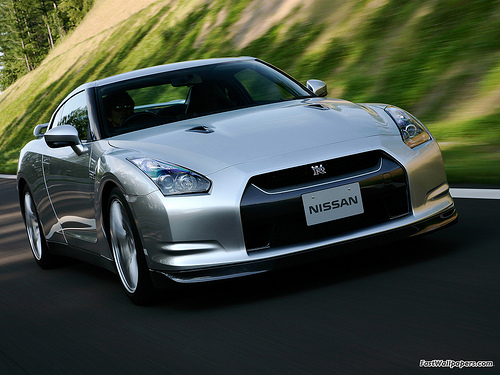
Check out the Nissan GT-R Gallery
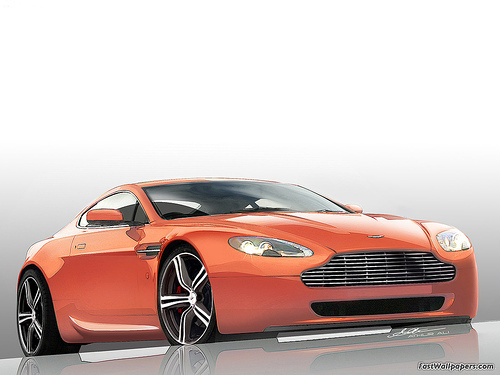
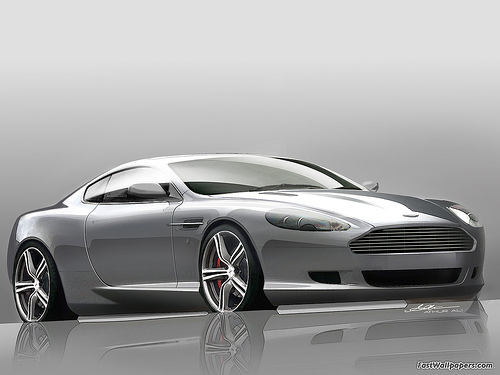
Aston Martin unveiled the DBS for the first time along with two new special editions — the Aston Martin DB9 LM and the V8 Vantage N400. Both special editions draw inspiration from the company’s recent achievements at Le Mans and the Nurburgring 24-hour races. The V8 Vantage N400 commemorates Aston Martin’s achievements at the Nurburgring, where the company enjoyed success in the grueling ADAC 24-hour race with the V8 Vantage N24 production racecar. Aston Martin develops and tests all of its road cars extensively on the Nurburgring Nordschleife circuit and the Vantage N400 recently broke the eight-minute benchmark around the legendary 14-mile circuit.
The 2008 Vantage N400 includes a number of performance improvements as well as enhancements to the car’s styling and standard features. The limited-edition model receives a needed boost in power to Aston’s 4.3 liter V8 engine, peak power rises from 380 to 400bhp, torque is up to 414lb ft. The handling has been improved as well, thanks to a Sports Package, which includes lighter-weight, graphite-finished alloy wheels and up-rated springs and dampers and a larger rear anti-roll bar.
The Vantage N400’s most noticeable exterior design improvement is the clear rear taillights. Side skirts have also received a more sculpted look. The Vantage N400 will be available in three new exterior colors; Bergwerk Black, Lightning Silver or Karussell Orange.
Interior enhancements include perforated black leather seats, micro-spin alloy interior trim and a unique numbered sill plaque. Transmission choice is between Sportshift automated manual or conventional manual transmission. Additionally, the Vantage N400 comes equipped with a range of normally optional equipment, including Satellite Navigation, 700W Aston Martin Premium Audio System, Bluetooth telephone preparation, HID headlamps, cruise control and memory/heated seats.
All in all the V8 Vantage has been a very good bargain form Aston and now it just got even better thanks to the upgrades in the M400 special edition.
The DB9 LM celebrates Aston Martin’s GT1 class victory in the Le Mans 24-hour endurance classic in June with the DBR9 — a racecar derived from the DB9.
This special edition car, available in Coupe form only with Touchtronic transmission, includes a unique Sarthe Silver exterior paint finish, meshes and rear crossbar finished in Magnum Silver and red brake calipers. Inside, the DB9 LM is fitted with handcrafted black leather finish, perforated leather inserts, unique “Tertre Rouge” interior trim and numbered sill plaque. The car is also equipped with the normally optional DB9 Sports Pack as standard, including the lighter-weight wheels seen on the Vantage N400.
Check out the Gallery’s of all three cars — DBS, N400, and DB9 LM